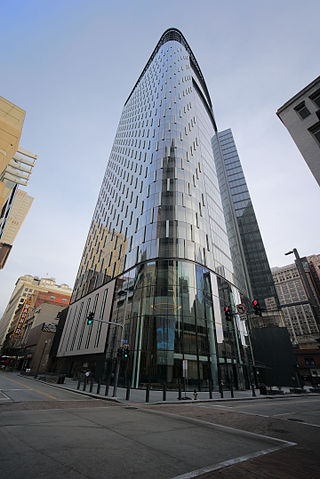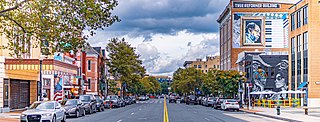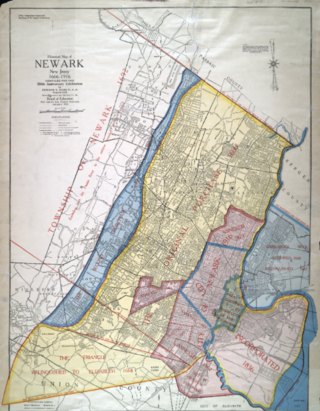
Newark is the most populous city in the U.S. state of New Jersey and the seat of Essex County. As of the 2020 census, the city's population was 311,549, an increase of 34,409 (+12.4%) from the 2010 census count of 277,140, which in turn reflected an increase of 3,594 (+1.3%) from the 273,546 counted in the 2000 census. The Population Estimates Program calculated a population of 305,344 for 2022, making it the 66th-most populous municipality in the nation.

Newark Liberty International Airport, originally Newark Metropolitan Airport and later Newark International Airport, is an international airport straddling the boundary between the cities of Newark in Essex County and Elizabeth in Union County, New Jersey. Located about 4.5 miles (7.2 km) south of downtown Newark, it is a major gateway to points in Europe, South America, Asia, and Oceania. It is jointly owned by the cities and leased to its operator, the Port Authority of New York and New Jersey. It is the second-busiest airport in the New York airport system behind John F. Kennedy International Airport but far ahead of LaGuardia Airport.

The Great Migration, sometimes known as the Great Northward Migration or the Black Migration, was the movement of 6 million African Americans out of the rural Southern United States to the urban Northeast, Midwest, and West between 1910 and 1970. It was caused primarily by the poor economic conditions for African American people, as well as the prevalent racial segregation and discrimination in the Southern states where Jim Crow laws were upheld. In particular, continued lynchings motivated a portion of the migrants, as African Americans searched for social reprieve. The historic change brought by the migration was amplified because the migrants, for the most part, moved to the then-largest cities in the United States at a time when those cities had a central cultural, social, political, and economic influence over the United States. There, African Americans established influential communities of their own. Despite the loss of leaving their homes in the South, and the barriers faced by the migrants in their new homes, the migration was an act of individual and collective agency, which changed the course of American history, a "declaration of independence" written by their actions.

The PNC Financial Services Group, Inc. is an American bank holding company and financial services corporation based in Pittsburgh, Pennsylvania. Its banking subsidiary, PNC Bank, operates in 27 states and the District of Columbia, with 2,629 branches and 9,523 ATMs. PNC Bank is on the list of largest banks in the United States by assets and is one of the largest banks by number of branches, deposits, and number of ATMs.
Conrail Shared Assets Operations (CSAO) is the commonly used name for modern-day Conrail, an American railroad company. It operates three networks, the North Jersey, South Jersey/Philadelphia, and Detroit Shared Assets Areas, where it serves as a contract local carrier and switching company for its owners, CSX Transportation and the Norfolk Southern Railway. When most of the former Conrail's track was split between these two railroads, the three shared assets areas were kept separate to avoid giving one railroad an advantage in those areas. The company operates using its own employees and infrastructure but owns no equipment outside MOW equipment.
The United New Jersey Railroad and Canal Company (UNJ&CC) was a United States-based railroad company established in 1872. It was formed by the consolidation of three existing companies: the Camden and Amboy Railroad, Delaware and Raritan Canal Company, and New Jersey Rail Road and Transportation Company. The Camden and Amboy and New Jersey Rail Road were among the earliest North American railroads. The Pennsylvania Railroad leased the United New Jersey Railroad and Canal Company in 1872.

The U Street Corridor, sometimes called Cardozo/Shaw or Cardozo, is a commercial and residential district in Northwest Washington, D.C., most of which also constitutes the Greater U Street Historic District. It is centered along a nine-block stretch of U Street from 9th to 18th Streets, which from the 1920s until the 1960s was the city's black entertainment hub, called "Black Broadway" and "the heart of black culture in Washington, D.C.". After a period of decline following the 1968 riots, the economy picked up with the 1991 opening of the U Street Metro station. Subsequent gentrification diversified the population, which is 67% non-Hispanic White and 18% African American. Since 2013, thousands of residents have moved into new luxury apartment buildings. U Street is now promoted as a "happening" neighborhood for upscale, "hip", and "eclectic" dining and shopping, its live music and nightlife, as well as one of the most significant African American heritage districts in the country.

Newark has long been the largest city in New Jersey. Founded in 1666, it greatly expanded during the Industrial Revolution, becoming the commercial and cultural hub of the region. Its population grew with various waves of migration in the mid 19th century, peaking in 1950. It suffered greatly during the era of urban decline and suburbanization in the late 20th century. Since the millennium it has benefited from interest and re-investment in America's cities, recording population growth in the 2010 and 2020 censuses.

Waddy Butler Wood was a prominent American architect of the early 20th century and resident of Washington, D.C. Although Wood designed and remodeled numerous private residences, his reputation rested primarily on his larger commissions, such as banks, commercial offices, and government buildings. His most famous works include the Woodrow Wilson House and the Main Interior Building.
Lowenstein Sandler is a New Jersey based American law firm with additional offices in New York, Palo Alto, New Jersey, Utah, and Washington, D.C. The firm has approximately 350 attorneys and has been described as "well connected" politically within New Jersey.

The Newark Public Library (NPL) is a public library system in Newark, New Jersey. The library system offers numerous programs and events to its diverse population. With eight different locations, the Newark Public Library serves as a Statewide Reference Center. The Newark Public Library is the public library system for the city of Newark, Essex County, New Jersey, United States. The library system boasts a collection of art and literature, art and history exhibits, a variety of programs for all ages. The library is home to author Philip Roth's collections.

U.S. Route 1/9 (US 1/9) is the 31.01-mile (49.91 km) long concurrency of US 1 and US 9 from their junction in Woodbridge Township in Middlesex County, New Jersey, north to New York City. The route is a multilane road with some freeway portions that runs through urbanized areas of North Jersey adjacent to New York City. Throughout most of its length in New Jersey, the road runs near the New Jersey Turnpike/Interstate 95 (I-95). In Fort Lee, US 1/9 merges onto I-95 and crosses the Hudson River on the George Washington Bridge, where the two U.S. Routes split a short distance into New York. US 1/9 intersects several major roads, including I-278 in Linden, Route 81 in Elizabeth, I-78 and US 22 in Newark, Route 139 in Jersey City, Route 3 and Route 495 in North Bergen, and US 46 in Palisades Park. US 1/9 also serves as the primary access point to Newark Airport. Between Newark and Jersey City, US 1/9 runs along the Pulaski Skyway. Trucks are banned from this section of road and must use US 1/9 Truck. The concurrency between US 1 and US 9 is commonly referred to as "1 and 9". Some signage for the concurrency, as well as the truck route, combines the two roads into one shield, separated by a hyphen (1-9) or an ampersand (1&9).

The Freedman's Saving and Trust Company, known as the Freedman's Savings Bank, was a private savings bank chartered by the U.S. Congress on March 3, 1865, to collect deposits from the newly emancipated communities. The bank opened 37 branches across 17 states and Washington DC within 7 years and collected funds from over 67,000 depositors. At the height of its success, the Freedman's Savings Bank held assets worth more than $3.7 million in 1872 dollars, which translates to approximately $80 million in 2021.

City National Bank was a regional bank headquartered in Newark, New Jersey with four branches in the New York metropolitan area. According to the June 2011 issue of Black Enterprise magazine, it was the seventh largest African-American owned and operated commercial bank in the United States.

Weequahic is a neighborhood in the city of Newark in Essex County, in the U.S. state of New Jersey. Part of the South Ward, it is separated from Clinton Hill by Hawthorne Avenue on the north, and bordered by the township of Irvington on the west, Newark Liberty International Airport and Dayton on the east, and Hillside Township and the city of Elizabeth on the south. There are many well maintained homes and streets. Part of the Weequahic neighborhood has been designated a historic district; major streets are Lyons Avenue, Bergen Street, and Chancellor Avenue. Newark Beth Israel Medical Center is a major long-time institution in the neighborhood.
The following is a timeline of the history of the city of Newark, New Jersey, United States.
Investors Bank was a publicly traded, full-service bank that was based in Short Hills, New Jersey, USA. The bank operated over 150 branches across New Jersey and New York.
Clement Alexander Price was an American historian. As the Board of Governors Distinguished Service Professor of History at Rutgers University-Newark, Price brought his study of the past to bear on contemporary social issues in his adopted hometown of Newark, New Jersey, and across the nation. He was the founding director of the Institute on Ethnicity, Culture, and the Modern Experience at Rutgers; the vice chair of President Barack Obama's Advisory Council on Historic Preservation; the chair of Obama's transition team for the National Endowment for the Humanities; a member of the Scholarly Advisory Committee of the Smithsonian's National Museum of African American History and Culture; and a trustee of the National Trust for Historic Preservation. He was appointed City of Newark Historian in early 2014. His service to New Jersey included appointments by Governors Brendan Byrne and Thomas H. Kean to the New Jersey State Council on the Arts, which he served as chair for two terms, and by Governor Christine Todd Whitman to the board of the Save Ellis Island Foundation, which he also chaired.
Mildred C. Crump was a councilperson on the Municipal Council of Newark from 1994-1998 and again from 2006-2021, and is the first Black woman to serve on the city's governing body. She was the first African American Braille teacher in New Jersey. InsiderNJ called her "legendary". Former Mayor Luis A. Quintana said of her “I see her as someone who was a pioneer as an African-American female".

The Freedman's Bank Building, previously known as the Treasury Annex, is a historic office building located on the corner of Madison Place and Pennsylvania Avenue NW in Washington, D.C. It sits on the east side of Lafayette Square, a public park on the north side of the White House, and across from the Treasury Building. The adjoining properties include the Howard T. Markey National Courts Building to the north and the former Riggs National Bank to the east.













